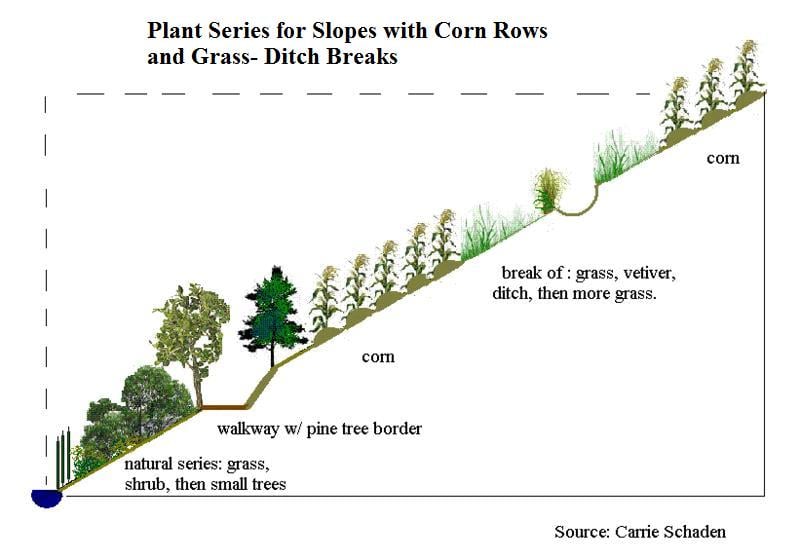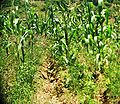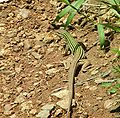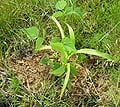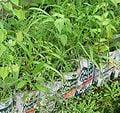
Terraces and ditches prevent erosion on steep slopes and create areas for farming. Terraces and ditches are dug according to the contour of the site and the terraces leave an edge over each trench. Water rather then flowing straight down hill follows the edges of these terraces thus this practice slows down the water and prevents massive soil erosion. If vetiver (a tall perennial grass) is planted in the mounds it helps further prevent erosion as its roots are established deep in the soil to secure it in place. The distance between these trenches depends on the slope. Petegral has demonstration of teracing both with vegitation as well as terracing using rock wall borders. This is one project in a series of soil conservation, groundwater recharge, and farming demonstration projects at the Permaculture Demonstration Center in San Andres Huayapam, Mexico, called Pedregal.
Deforestation is one of the greatest contributers to soil errosion. Without tree roots firmly forming a matrix to stabalize the soil land erodes from slopes and hills. What soil remains is left to the mercy of the wind and rain, and this eroding soil drags everything it encounters down with it.[1] In Oaxaca as well as other places in Mexico campesinos (or small farmers) have been pushed off their land and often find that the only avialable land left for their small farm is on forested slopes. For this reason Petegral wanted to create a center that demonstrated different applications of farming on steeply sloped hills previously deforested. Some of their techniques demonstrated include: terraces, ditches, buffers of perrenial grasses, and mixed or polyculture planting.
Terraces[edit | edit source]
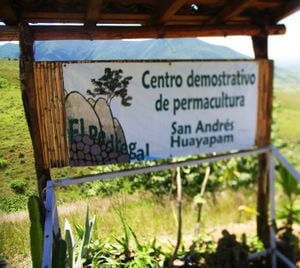
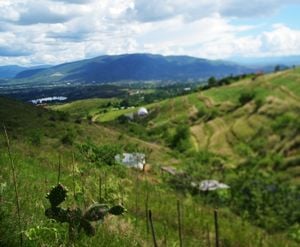
Terraces can help reduce soil errosion. Terraces curve around sloped landscapes following level ground. Terraces are parallel to eachother and horizontal along the hill thus creating a new pathway for water that helps slow the water down. Slowing down the water allows: water to percolate into the soil for a longer period of time for use by plants and regeneration of the local aquifer and it reduces errosion that ocucrs in high rain periods of flash flooding. In Oaxaca the total average rainfall is 1051 mm (or 41.38in) per year, but most of this falls in June when about 263 mm (or 10.4 in) of rainfall occurrs across 12 days. This means when it rains it rains very hard and errosion is a reocuring problem throughout Oaxaca.[2]
Construction of Terraces and Levels[edit | edit source]
To create terraces you must find level ground. At level ground you want to mark the edge of your terrace and this can continue for as long as the contour of the hill will allow. Devices for finding level ground include the cheap and functional Apparatus A below.
Aparatus A frame[edit | edit source]
Materials[edit | edit source]
- 2 sticks of wood 2.5 meters long
- strong wire to secure sticks in place
- 1 stick of wood 2 meters long
- 3 meters of resistant wire for hanging
- a rock or other object aproximatly 1.5 kg to create tension on hanging wire
Constructing Aparatus A[edit | edit source]
- The 3 sticks should be shaped into an A with each leg fixed at the same distance from the center, about 30cm from the center.
- The center horizontal stick should be placed 2.10 m up along the side legs, which ends up a little bit above hip height after the legs are angled.
- The rock should hang 5 cm from the top of the center horizontal stick
- Last mark the middle point on the center horizontal stick where the rock should hang over if the land is level.
Using Aparatus A to Find Level Ground[edit | edit source]
- Determine the height of the first terrace and mark the point with a stake.
- At the point of the stake lean one leg of Apparatus A, which should remain fixed while locating the second point.
- Move the second leg around untill the middle hanging wire passes over the central mark on the central horizontal stick. This is level.
- Then nail one stake at this second point.
- Continue this procedure for the total contour.[3]
Series of Plants for Terracing with Vegetation[edit | edit source]
Option 1 with Corn Rows and Grass-Ditch Buffers[edit | edit source]
Series of Plants with Corn Rows and Grass Ditch Buffers[edit | edit source]
Water Loving Grass, Shrubs, Trees
- Starting from the river edge a series of first water loving grasses, then shrubs, then small trees are established going out from the banks. This natural pattern was repeated at Petegral after microfilter dams were placed along the creeks and river to help remove soils and silts from flowing off the land and into the water way and to create zones of revegetation along these creek beds. This series of grass, shrub, small tree goes out from the bank for 20 feet. The roots of the vegetation forms a matrix that helps secure the soil in place.
Walkway with Pine Tree Border
- After this series Petegral has a narrox walk way for maintenance, that is as wide as a wheel barrow.
- After this walkway baby pine trees have been planted and annual grasses grow up hill for another 6 feet.
Corn Milpa in Rows
- After the second series of grasses a corn ¨milpa¨ is planted containing 9 to 10 rows of corn over 20 feet of run up hill, with corn planted for as long horizontally as the contour of the terrace will allow. The corn is planted on raised beds that are less then 6 inches high and squash plants are intersperced between corn plants. While corn grows tall, these squash grow wide providing further ground cover for freshly tilled soil.
Buffer of: Grass, Vetiver, Ditch, then more Grass
- After the milpa perrenial grasses grow for 5 to 6 feet of run. On the furthest edge of these grasses, vetiver, a very hardy grass is planted. Vetiver has a crystaline structure in its cells, which makes it very sharp and unapatizing to many animals and especially popular for soil restoration efforts.
- Ditches are generally 2 ft wide and the depth depends on the slope, amount of rainfall, and vegetation. Vetiver grass can be planted on the edge of a ditch that is 5-12 inches in height, while on the higher edge maguey cactus can be planted on the edge of a ditch that varies from 12- 17 inches in height.
More Corn and more Buffers
- After the buffer series another corn milpa of 9-10 rows of corn follows, with this sequence repeating itself all the way up the hill. In total the eastern facing hill has 4 of these milpas.
Option 2 with Polyculture Corn mix, No Till, and Ditches[edit | edit source]
Polyculture and No Till Techniques[edit | edit source]
- Rather then planting in rows and tilling, the west facing slopes instead use a dig technique where only about one foot in diameter of the soil is directly disturbed for planting corn or beans. This reduces the disturbance of the soil and allows for the natural soil cover and vegetation to remain.
- A polyculture of many different plants are intersperced among one another including: corn, beans, squash, cactus, shrubs, and wild grass. Tall annual grasses also establish themselves in between the plants much easier with this technique and may cause some problems with shading.
Series of Plants with Polyculture, No till, and Ditches[edit | edit source]
Grass, Shrub, Trees from river edge
- from the river bottom there is about 30 ft of wild grasses, established shrubs, trees, and fruit trees.
Polyculture with Corn
- then about 20ft of polyculture mixed corn, beans, cactus, shrubs, and fruit trees.
Ditch
- then a ditch that is 1.5 ft wide and vetiver planted on the lower side of the ditch
More Polyculture and More Ditches
- the polyculture mix is repeated and then again followed by another ditch all the way up the hill
Planting Vetiver[edit | edit source]
Timing to Plant Vetiver[edit | edit source]
Planting vetiver is best done at the same time corn planting is done. The rainy season should be well established by this time, around May and June, depending on the location, this rain will allow for there to be sufficient soil moisture for the vetiver. If irrigation is available all year, then its best done when the danger of frost is gone.
Taking Baby Plants from an Older and Full Bed[edit | edit source]
Even though an adult vetiver plant is very strong and resilient, newly planted plants are delicate and should be treated well so that the seed will not fail. Newly uprooted baby vetiver plants taken from the edges of older beds, should be placed in a nursery with high humidity. Prune back baby grass leaves till the blades are only 20cm tall, this is partly because the disturbed and reduced root structure, after being dug out of the edge of the bed, can not support the same amount of foliage. Also prune back the roots to 10cm, partly for increased ease in replanting the baby vetiver. Each plant must have 2 or 3 healthy looking stems.
How to Plant Vetiver Barriers[edit | edit source]
In a place where rain is scarce vetiver should be planted at the bottom of the ditch, in a place where it rains a lot is better to be planted at the edge of the ditch. Planting can be facilitated with a simple planting stick or shovel. Baby plants should be planted along the contour with about 10cm between each plant. The field should be well wet, and the baby plant should be planted about 3 cm below the surface of the earth and the soil slightly compacted on the sides.
A barrier is fully established when the plants have come together and form a dense row.
References[edit | edit source]
- ↑ Lopex, Laura. L., Esteva, Gustavo., Consejo, Juan J., Padilla, Eugenio., Robles, Marcela., and Alejandre, Virginia. Defensa Ecologica: Manual de Tecnicas. 2a. edition. Oaxaca, 1998.
- ↑ http://web.archive.org/web/20160308161048/http://climatetemp.info/mexico/salina-cruz-oaxaca.html
- ↑ Lopex, Laura. L., Esteva, Gustavo., Consejo, Juan J., Padilla, Eugenio., Robles, Marcela., and Alejandre, Virginia. Defensa Ecologica: Manual de Tecnicas. 2a. edition. Oaxaca, 1998.
